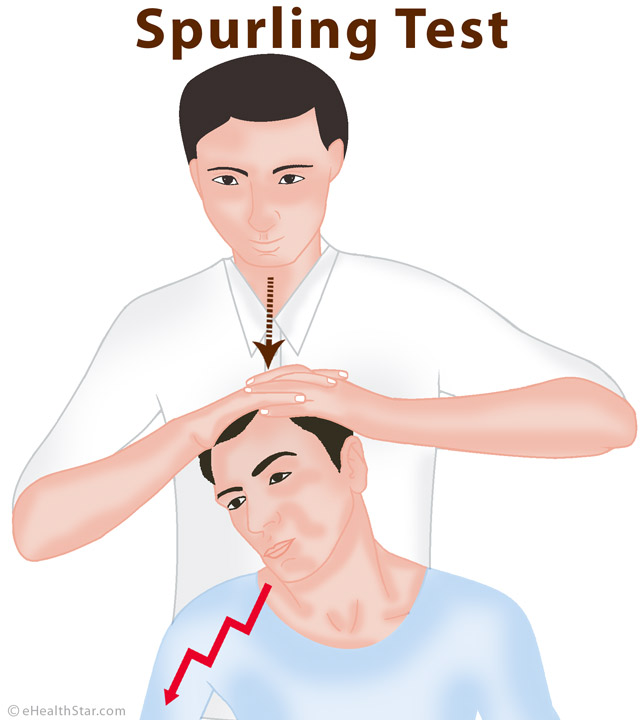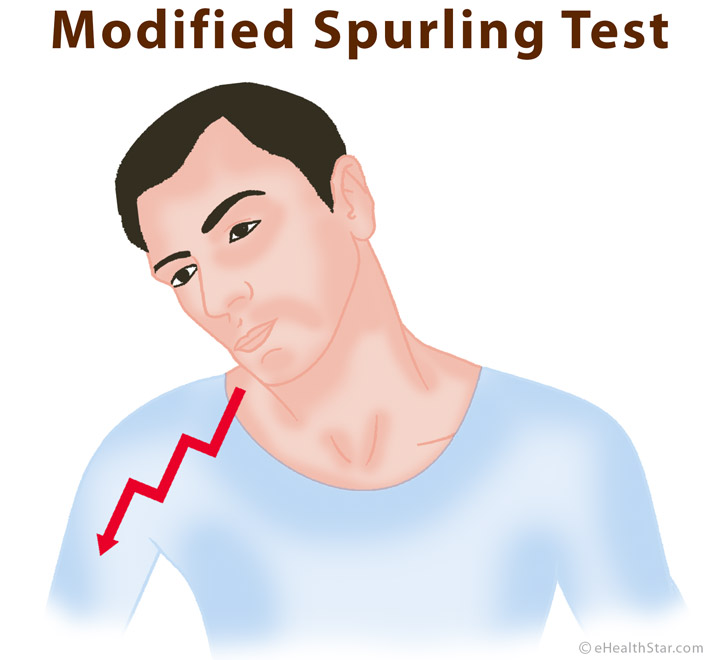What is the Spurling’s test?
The Spurling’s test or maneuver is a provocative test to evaluate if the patient’s arm pain arises from a pinched nerve in the neck spine (cervical radiculopathy).
Other names: foraminal compression test, axial cervical compression test, quadrant test.
How is the test performed?
A doctor applies a downward pressure on the head of a patient who is seated with his/her neck slightly extended backwards and the head tilted to one side (Picture 1). A doctor should release the pressure as soon the patient feels the pain and should not try to “rate” the pain by sustaining the pressure.

Picture 1. Spurling’s test (axial cervical compression test)
Pain radiating down the arm suggests a pinched nerve in the neck.
Positive Spurling’s Test (Sign)
A positive Spurling’s sign means pain in the shoulder or upper arm on the same side to which the head is tilted.
Positive test (pain after applying pressure) is quite specific for a pinched nerve in the neck (cervical radiculopathy) and greatly reduces the probability of other conditions as a source of pain [1]. The test does not seem to be very sensitive, which means it is positive only in about half (30-90%, according to various studies) of patients with a pinched nerve in the neck [1,2,4].
A pain that appears in the neck on the opposite side of that to which the head is tilted is caused by increased muscle tension rather than a pinched nerve.
Negative Spurling’s Test
Negative test (no pain) does not exclude a pinched nerve [1].
Variants of the Spurling’s Test
Modified Spurling’s Test
A patient maximally extends the neck and turns the head toward one side. Pain radiating down the arm suggests affected spinal nerve root in the neck (Picture 2).
Picture 2. Modified Spurling’s test
The Reverse Spurling’s Test (Cervical Distraction Test)
A patient is lying on the back, face-up. A doctor stands behind the patient and puts one arm under his/her chin and the other one below his/her head and pulls it away from the body along the body axis. Pain relief during the test suggests a pinched nerve in the neck [3]. If the patient does not feel pain relief, his/her pain less likely originates from a pinched nerve [3].
A pinched nerve in the neck as a source of pain is even more likely when other tests, such as shoulder abduction test and Valsalva maneuver, are also positive. The Spurling’s test is not used to evaluate pinched nerves in the lumbar spine.
Contraindications
The test should not be performed right after a severe neck injury.
- References
- Malanga GA, Cervical radiculopathy, clinical presentation Emedicine
- Shabat S et al, 2012, The correlation between Spurling test and imaging studies in detecting cervical radiculopathy PubMed
- Over DR et al, 2010, Provocative Diagnostic Testing for Cervical Radiculopathy American Family Physician
- Rubinstein SM et al, 2007, A systematic review of the diagnostic accuracy of provocative tests of the neck for diagnosing cervical radiculopathy PubMed Central



I am seeing where daily records show “foraminal compression test” was positive every treatment date, generally 3 times a week. Treatments were PT and some chiropractic adjustments.
My position is that any such provocative testing provokes the condition it tests for, the claimed cervical radiculopathy would be continually reproduced, exacerbated, possibly aggravated or even originally produced by repetitive compression and irritation of the nerves. This iatrogenic testing could only extend treatment times and served no significant clinical purpose. Only an occasional retest would be reasonable, and have a good harm vs benefit ratio.
The problem is I am searching for literature to support my statements, to withstand Daubert hearings regarding acceptable evidence. Common sense may not be enough!
Can you help me?
Don Morris DC, I haven’t found any warnings about the Spurling’s test during my (limited research). Perhaps an experienced orthopedist or neurologist could tell more.